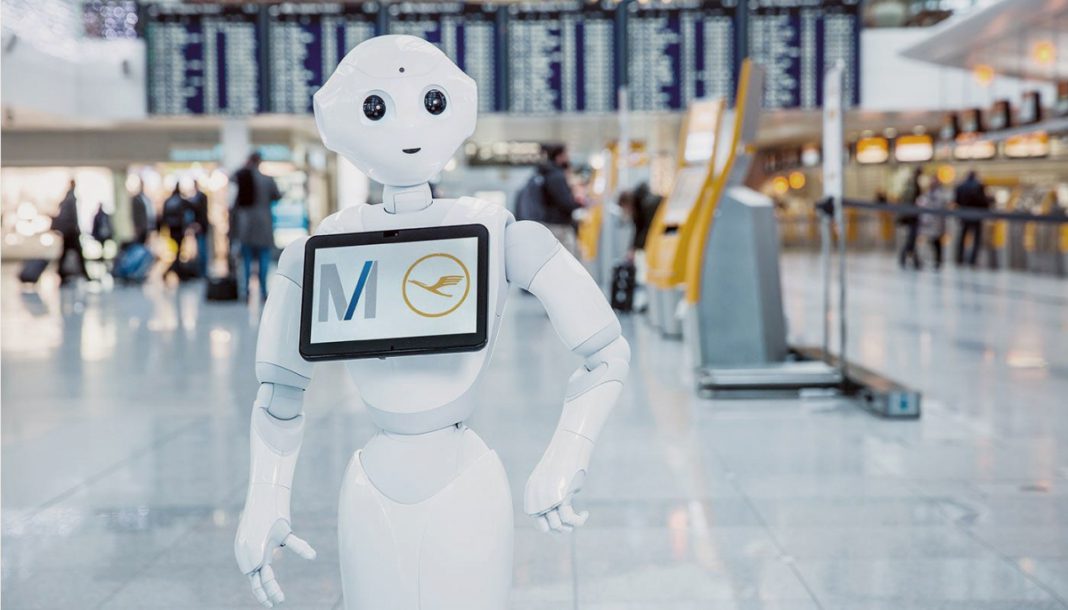The beginning of a new year brings with it an opportunity to take a look at the trends, as well as the new and emerging technologies, which will shape the air transport industry over the next 12 months and beyond, a report said. The report by Future Travel Experience features 10 trends that will play a crucial role in improving passenger experiences and enhancing business performance, exploring everything from automation and robotics to the metaverse and Urban Air Mobility.
Automation and robotics
Autonomous robots are becoming increasingly prevalent at airports for the delivery of retail and food & beverage. Pittsburgh International Airport, through its xBridge Innovation Center, is among those having implemented the technology.
Perhaps an overriding trend this year and beyond will be increasing automation, using technology to streamline operations and offset rising labour costs. As this report in Forbes indicates: “Labour has typically represented about 25 per cent of an airline’s cost. Over the next few years, many have forecasted that this will move to north of 40 per cent.”
Meanwhile, Heathrow is refurbishing and modernising a cargo tunnel with updated mechanical and electrical services. The robot dog allows the project team to safely retrieve data from the building site, which is then used alongside 3D models and augmented reality to track accuracy and progress on the construction work.
“Heathrow’s vision is to give passengers the best airport experience in the world and, in order to do that, we need great people, and we also need innovation,” said Emma Gilthorpe, Chief Operating Officer, Heathrow. “Dave the Dog has been a fantastic innovation enabling us to perform the tasks that we need to do – using robotics and automation.”
Artificial Intelligence and Machine Learning
While Artificial Intelligence (AI) and Machine Learning (ML) come under the umbrella of robotics, we think it’s worth mentioning them in their own right.
ChatGPT – a chatbot utilising AI and ML, which was launched by OpenAI in November and is generating a lot of attention. It is, of course, very early days, but we are excited about the possible applications in aviation and how it might be utilised.
Korean Air is among the airlines working towards introducing a machine learning management service, which will allow the airline to create, train and apply machine learning models to improve customer service by forecasting passenger and cargo demand more accurately.
Narita International Airport is proactively incorporating robotics and AI to promote business efficiency and enhanced productivity. It is also moving forward with the use of AI with the aim to improve customer satisfaction by using and analysing AI trained on real customer feedback.
Metaverse, digital twin and NFT
Qatar Airways has entered the metaverse with the launch of QVerse, a novel virtual reality (VR) experience for visitors to the airline’s website. Users of the www.qatarairways.com/QVerse website can virtually tour and navigate the Premium check-in area at Hamad International Airport, and the cabin interior of the airline’s aircraft, by using their own Personal Electronic Devices. The carrier is also the first global airline to introduce a MetaHuman cabin crew offering a digital interactive customer experience.
The metaverse – essentially an immersive virtual reality experience where people can interact with digital objects and digital representations of themselves and others – remained a hot topic at last week’s CES 2023.
In its recent ‘Meet the Megatrends’ report, SITA also highlighted that: “By 2030 metaverse operations will be commonplace at leading airports and play a vital role in optimising processes, avoiding disruption, and facilitating intuitive, immersive control of intelligent airports.”
Bangalore International Airport Ltd (BIAL) – operator of Kempegowda International Airport, Bengaluru (BLR Airport) – has entered the metaverse with a T2 digital twin. It recently announced the first phase launch of the ‘BLR Metaport’ in collaboration with Amazon Web Services (AWS) and Polygon, which offers an immersive, 3D virtual experience of the newly-launched Terminal 2.
Qatar Airways has entered the metaverse with the launch of QVerse, a novel virtual reality (VR) experience for visitors to the airline’s website. Users of the www.qatarairways.com/QVerse website can virtually tour and navigate the Premium check-in area at Hamad International Airport, and the cabin interior of the airline’s aircraft, by using their own Personal Electronic Devices. The carrier is also the first global airline to introduce a MetaHuman cabin crew offering a digital interactive customer experience.
Personalization
Travelers increasingly expect end-to-end personalization at every step of their journey. At CES 2023, Delta Air Lines demonstrated how it is responding by showcasing Delta Sync – its vision for more personalized travel, which brings together an ecosystem of digital services and experiences.
Rolling out in 2023, Delta Sync is underpinned by SkyMiles membership and catalyzed through free Wi-Fi to deliver personalized and exclusive inflight entertainment, more ways to enjoy onboard food & beverage, and exclusive partnerships with top consumer brands.
New approaches to retailing
Significant steps forward in the transformation of airline retailing are taking place, with payment innovation, booking innovation, and all-you-can-fly subscription services.
A recent example is Finnair’s collaboration with Amadeus to build a next-generation airline retail offering, with personalization and real-time insights. “Better retailing capabilities including dynamic pricing, upselling, cross-selling, bundling and unbundling support our target of boosting revenues and improving profitability,” said Antti Kleemola, Chief Information Officer, Finnair.
Icelandic low-cost carrier PLAY has also taken a new approach with its Internet Booking Engine (IBE). As part of this, it is planning the implementation of new features such as flight bundles, stopover flights and local payment options.
Aeromexico is utilising NDC technology to further enhance the shopping experience by providing richer and more customized content and supporting better upsell of its branded and ancillary products. “We are on our way to create a new marketplace for customized travel,” said Aaron Murray, Chief Commercial Officer, Aeromexico.
Meanwhile, a contactless retail experience is also being extended to an increasing number of airports. In September, Dallas Fort Worth International Airport opened three innovative concessions featuring grab-and-go technology – two featuring Amazon’s Just Walk Out Technology and one powered by Zippin. Meanwhile, in this interview with FTE, Sammy Patel, Vice President Commercial, Vantage Airport Group & Chief Executive Officer, Midway Partnership, explained how Vantage is “flexing its innovation muscle” with contactless commercial offers.
Urban Air Mobility
Urban Air Mobility continued to gain momentum last year, with several airlines and airports around the world accelerating this continuing trend. Groupe ADP and Skyports have unveiled a passenger terminal testbed for future electric vertical take-off and landing (eVTOL) in Paris, with plans for commercialisation in 2024.
Biometrics and digital identity
iGA Istanbul Airport has started testing the Star Alliance Biometrics access system in collaboration with Turkish Airlines as part of efforts to deliver a contactless travel experience. The biometric identification system is designed to enhance the travel experience of frequent flyer programme members of Star Alliance member airlines.
Biometrics has become a perennial fixture in our annual trends report. The post-pandemic preference for contactless technologies has only served to accelerate biometric adoption and its acceptance by travelers. IATA’s 2022 Global Passenger Survey indicates that: “Passengers see value in biometric identification. 75 per cent of passengers want to use biometric data instead of passports and boarding passes.”
Private Networks
Private wireless is one of the hottest opportunities for air transport stakeholders – a foundational core enabling technology that provides the connectivity needed for an “internet of everything” to support anything from autonomous vehicles on the ramp through to optimised operations at the gate for airlines.
The technology was explored at FTE Global 22 in the successful Private Networks Symposium, featuring Miami International Airport, Dallas-Fort Worth International Airport, Metropolitan Airports Commission, Barich, Inc and ExteNet Systems.
Return to collaboration with startups
Aeroporti di Roma (ADR) recently launched a second ‘Call for Ideas’ from startups. After the success of the first ‘Call for Ideas’, which saw the implementation of 10 projects selected from over 100 applications, this new round of ADR’s acceleration programme will offer eight successful applicants the opportunity to work on their projects directly from the ADR Innovation Hub, which was inaugurated in October 2022 and is located at the heart of Rome Fiumicino Airport’s Terminal 1.
During the pandemic, collaboration with startups inevitably took a back seat. Now that the industry is truly back up and running it is firmly back on the agenda, with progressive airports and airlines increasingly collaborating with high potential startups and scaleups.
The exponential growth of the FTE Digital, Innovation & Startup Hub demonstrates this trend, which we expect to further accelerate in 2023 and beyond.
Sustainability
Air New Zealand has announced four innovators it will be working with on its mission to have its first zero emissions demonstrator flight – either cargo or passenger – take to the skies from 2026: Eviation, Beta, VoltAero and Cranfield Aerospace.
A common theme throughout the majority of innovation projects taking place across air transport is sustainability, which remains a key priority following the global industry’s commitment to reaching net zero carbon emissions by 2050.
Net zero will be reached through a combination of initiatives, including Sustainable Aviation Fuels, new aircraft technology, more efficient operations and infrastructure, and the development of new zero-emissions energy sources such as electric and hydrogen power.
10 tech trends that can enhance airline and airport operations


